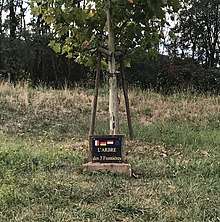Schengen, Luxembourg
Schengen (Luxembourgish: [ˈʃeŋɡən] (![]()
Schengen Schengen | |
|---|---|
 A view of Schengen | |
 Map of Luxembourg with Schengen highlighted in orange, and the canton in dark red | |
| Coordinates: 49.47°N 6.36°E | |
| Country | |
| Canton | Remich |
| Area | |
| • Total | 31.42 km2 (12.13 sq mi) |
| Area rank | 24th of 102 |
| Highest elevation | 302 m (991 ft) |
| • Rank | 98th of 102 |
| Lowest elevation | 141 m (463 ft) |
| • Rank | 5th of 102 |
| Population (2018) | |
| • Total | 4,812 |
| • Rank | 32nd of 102 |
| • Density | 150/km2 (400/sq mi) |
| • Density rank | 47th of 102 |
| Time zone | UTC+1 (CET) |
| • Summer (DST) | UTC+2 (CEST) |
| LAU 2 | LU0001206 |
| Website | schengen.lu |
After the mergers with Burmerange and Wellenstein in 2011,[1] the commune has a population of 4,223 with an area of 31.42 square kilometres (12.13 sq mi).
The largest settlement within the commune of Schengen is Remerschen after which the commune used to be named. The name of the commune was changed in 2006[2] to take advantage of the Schengen's name recognition after the signing of the Schengen Agreement there in 1985.
Schengen Castle dates from 1390 but was almost completely rebuilt in the 19th century.[3]
Populated places
The commune consists of the following villages:
|
|
|
European Museum
The European Museum was opened on 13 June 2010, 25 years after the signing of the Schengen Treaty, in the Centre européen building.
The permanent, trilingual exhibition on the history and significance of the Schengen Agreements, on 200 m2 (2,200 sq ft) of exhibition space, shows visitors the elimination of the control of persons at the internal borders, put into practice as one of the four foundational European freedoms in the 1957 Treaty of Rome. The signing of the Agreement is documented with historic photos and video and sound footage as well as statements by those involved at the time.
Twin towns — sister cities
Schengen is twinned with:[4]

References
- "Fusion des communes de Burmerange, Schengen et Wellenstein". Legilux. Government of Luxembourg. Retrieved 13 June 2015.
- "Loi du 24 juillet 2006 portant changement du nom de la commune de Remerschen en celui de Schengen" (PDF). Journal Officiel du Grand-Duché de Luxembourg: 2661. 30 August 2006. Retrieved 27 December 2012.
- "Das Schloss von Schengen", Schengen a.s.b.l. (in German) Retrieved 27 March 2011.
- "Jumelages". cchengen.lu (in French). Schengen. Retrieved 2019-09-05.
External links
| Wikivoyage has a travel guide for Schengen. |

- Schengen-Tourist

